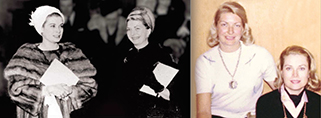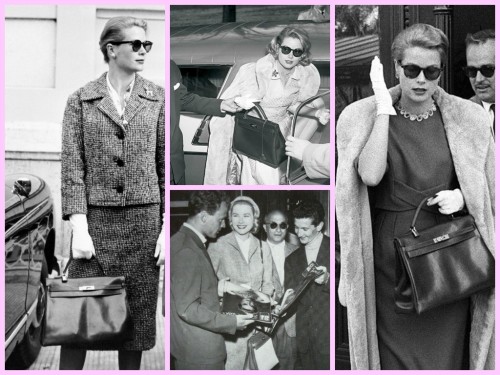
It’s probably the most famous bag in the world, and one of just a few called by its first name. The “Kelly” bag is named after the actress Grace Kelly, who used one of her two favorite Hermès bags to shield her pregnant stomach from the prying eyes of the paparazzi in 1956. Photographs of her covering her baby bump with her hallowed Hermès bag were seen all over the world and even made it onto the cover of Life magazine! The Kelly bag and its namesake, Grace Kelly, became icons of fashion at that time, and both remain the classic image of elegance to this day.
Princess Charlene Bump – an heir is in the bag
Princess Charlene of Monaco demonstrates how to carry the Louis Vuitton Capucines Bag with the front flap exposed and the LV hardware hidden – Discretion is important for royalty, after all. Could this be the new generation of the Kelly Bag to cover Princess Charlene’s Bump?
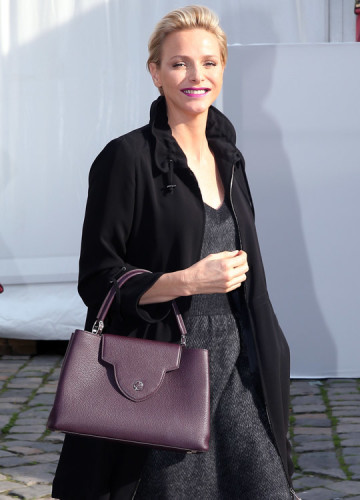
Or will this ARMANI bag become the new iconic style thanks to Princess Charlene’s bump (particularly if she has twins) – after all, her wedding dress was designed by Armani.

In what could possibly be the smallest press release by the Palace of Monaco, on May 30th, 2014 the pregnancy of H.S.H. Princess Charlene was officially announced.

Princess Grace adored her Hermes Bag to the end
As evidenced in this photo (Joan Dale sitting across from Princess Grace, Prince Rainier, and Prince Albert on a train ride back to Paris after the last family holiday in August of 1982 – as written in diary format in “My Days with Princess Grace of Monaco”) Princess Grace cherished her Hermes bag to the end… as well as her mink-lined raincoat, which was the first coat that she bought with her own money from acting, that came in handy during this cruise to the Arctic.
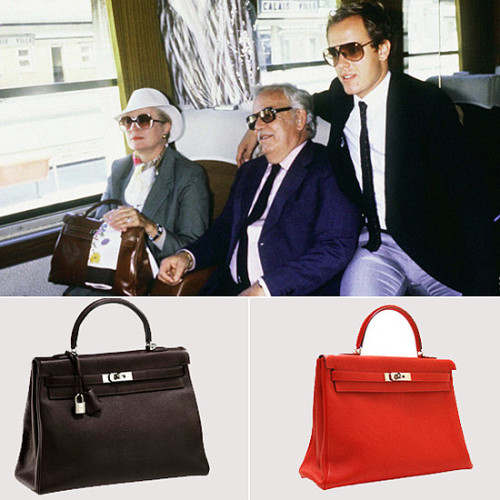
History of the Grace Kelly Bag
(courtesy of sofeminine.co.uk – a leading women’s publisher and Hermes)
In its early days, Hermès was mainly a saddlery, founded in 1837 by ThierryHermès. The development of the automobile drove Emile, Thierry’s young son, to start crafting leather accessories, and the first Hermès bag was designed for chic behind the wheel.
In 1923 Emile Hermès and Ettore Bulgatti created a very plain, simple bag for Emile’s wife Julie, which was designed to fit in a car door. The Bugatti bag was designed to allow riders to carry their saddle and was the inspiration for the Kelly, above.
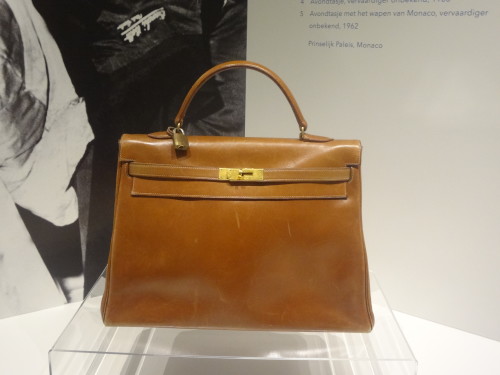
The Original Grace Kelly Bag on Exhibit
Aside from its distinctive trapezoid shape, rigid bottom standing on four metallic studs, its flaps, its triangular gussets and its curved, sculpted handle, the other essential features that identify a Kelly bag are the straps that cross over the clasp, the padlock and the little bell that protects the key.
Each Kelly bag is made by a single craftsman at Hermès. Every year, the company buys hundreds of animal skins for its 12 production sites, all based in France. The most precious skins are handled in Pantin (in the outskirts of Paris) and in the specialist workshop on rue du Faubourg St Honoré (in central Paris).
There are more than twenty steps in the transformation of animal skin into bag, all standardised, and almost 200 different techniques, including plucking, gumming, smoothing, thinning down, treating and massaging. The skin has to become completely smooth.
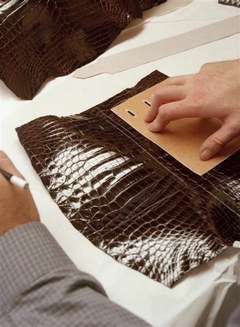
© Hermès
Next stop is the cutting workshop. Here, each piece of skin is numbered before being pieced together with other parts to make up a bag. Three skins are required to make one Kelly bag.
Each bag is made by one craftsman only. The work required on precious skins such as crocodile, ostrich and lizard skin is all handled by experienced craftsmen.
All this work is performed with care, patience and love by a craftsman who takes around twenty hours to sew, stitch, glue and assemble the 36 pieces of leather that make up a Kelly bag, before adding his signature.
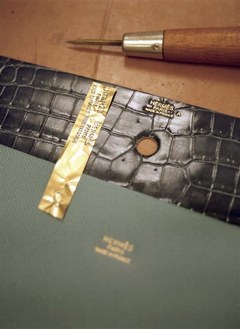
© Hermès
About Hermes
Five generations of visionary men, all devoted to the demands and desires of their clientele, made Hermès what it is today. Here’s an insight into the history of this renowned luxury brand.
Thierry Hermès was the founder of the company. Born in 1801 in Krefeld, Germany, his Protestant family fled the country and settled in Paris in around 1828. He died in 1878. Thierry travelled a lot throughout his life, but eventually returned to the French capital where, in 1837, he opened his first shop. It was a saddlery workshop that made and sold harnesses and equipment for horses.
Intensive use of horses was booming in Paris, giving rise to great competition among the best coachbuilders, saddlers and harness makers. They had to excel at their trade to satisfy demanding clients.
The descendants of Thierry Hermès, Émile-Maurice, Adolphe and Robert Dumas-Hermès, continued the development of the company into quality luxury products such as the Kelly bag, cashing in on the rapid growth of the baggage industry through the development of the automobile. Thierry Hermès passed away, leaving his successors to take over the trade which he was so passionate and enthusiastic about.
Following the renovation of Paris, commissioned by Napoleon III and led by Baron Haussmann, the Hermès fashion house set up shop at 24 rue du Faubourg Saint Honoré in around 1880. This narrow Parisian street, located in a notoriously wealthy and fashionable area close to the Champs Elysées, brought the company closer to its prosperous clientele.
At the beginning of the 20th century, the Haut à Courroies bag, ancestor to the Kelly, went on sale.
A harness-shaped moving instrument preserved at the first Hermès workshop bears witness to Thierry Hermès’ labours to adjust the harness exactly to fit a horse’s neck. At the 1867 Universal Exhibition, the hard-working craftsman was awarded the 1st class medal.
After buying out his brother’s shares in 1922, Emile-Maurice successfully diversified the Hermès label with the addition of belts, gloves, couture, jewellery, watch bracelets, travel bags, sports and driving accessories.
The innovative zip closure system attracted a lot of attention in a time when everyone was obsessed with speed, and the Hermès craftsmen who mastered the zip system used it on Mademoiselle Chanel’s models.
Some of Hermès’ most famous creations came about after the Great Depression of 1929: the Hermès diary, silver bracelet, riding jacket and riding gear soon became must-have items that were instantly recognisable as Hermès. The silk used for jockeys’ jerseys was the inspiration for the iconic Hermès scarf. A factory that manufactures scarves alone was established in Lyon in 1937.
Hermès celebrated its centenary in 1937. Shops sprang up all over France (in Cannes and Biarritz in the south and Deauville in the north). The signature orange boxes and gift ribbon, along with the iconic horse and carriage of the Hermès logo, achieved international renown. Emile-Maurice Hermès died in 1951.
In 1928, Robert Dumas-Hermès married the daughter of Emile-Maurice Hermès, with whom he would become an active business partner. Taking the reins in 1951, he never abandoned his creative activities and concentrated specifically on designing scarves.
Emile-Maurice was eager to use a variety of materials to produce objects that were intended to make everyday life easier and more beautiful. He continued to diversify the brand by branching out into sustainable products such as the tie in 1949, followed by a perfume (eau d’Hermès) which was developed by Jean-René Guerrand in 1950.
Thanks to the talents of Annie Beaumel, the windows of the flagship store on rue du Faubourg Saint Honoré became a scene of enchanting theatre and a Parisian meeting point for celebrities including Grace Kelly, the Duke and Duchess of Windsor, Sammy Davis Jr, Ingrid Bergman and Jackie Kennedy. In 1978, Robert Dumas-Hermès died.
Jean-Louis Dumas-Hermès took over the company in 1978 and, along with his cousins, instilled youthful enthusiasm into it. He brought new ideas to Hermès’ silk, leather and ready-to-wear fashion, and set up new lines using traditional techniques. He launched the Hermès watch in 1978 via a Swiss subsidiary then introduced enamel and porcelain into the collections, followed by gold, silver and crystal. With a clear view of the future, Jean-Louis Dumas-Hermès brought spectacular growth.
Hermès celebrated its 150th anniversary in 1987.
For Hermès’ 150th anniversary in 1987, the company organised a huge celebration on the River Seine in Paris featuring a spectacular show of lights, colours, fireworks and flares. To lead the celebratory procession, sculptures of craftspeople on horses were created. Armed with their fireworks, they portrayed both the memory of bygone pomp and the symbol of serene modernity, ready to ride into the future.
The craftsman became a new Hermès symbol and today the equestrian statue can be seen atop each of the four Hermès flagship stores around the world as well as in workshops.
Now the epitome of French luxe, the brand continues to affirm its unique values of traditional craftsmanship. The profile of a horse-drawn carriage with driver is instantly recognisable as the Hermès logo.

© Hermès
The logo is based on a drawing by Alfred de Dreux, entitled “Duc Attele, Groom a L’Attente”. Bought by Emile-Maurice Hermès for his curio-filled office back in the 1920s, the drawing still hangs above the fireplace in the collector’s old study, located on the second floor of 24 rue du Faubourg St Honoré.
Hermes Stores are now worldwide. Find a Kelly Bag for sale
Fun Fact: When “to handbag” is a Verb
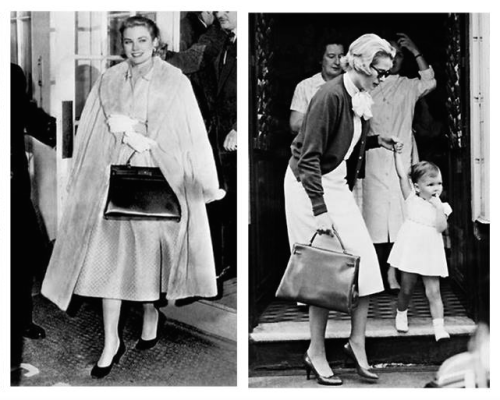
Princess Grace Kelly Bag
